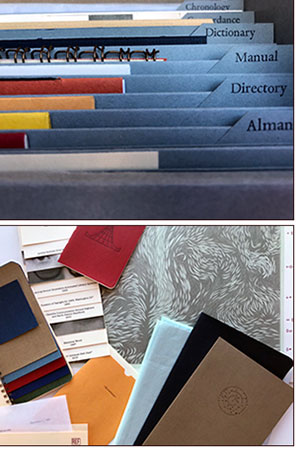
|
|
Share this page: |
| Statement: " My work is the result of my perpetual pursuit of knowledge and understanding. As a child I realized quickly that the accumulation of information far exceeded the quantity that a dedicated classroom teacher had patience or time enough to teach me. I approach my work initially as a scientist approaches their research. I first gather information from primary sources. As the search images develop I follow a considerably less linear path and am attracted by the unexpected and overlooked. The disregarded records, figures or facts merge and become the atypical moments that facilitate my knowledge of materials, technology and objects. These moments nourish intuition and lead to invention. The combination of research, information and play is the subject of my work.". | |
Rain/fall |
|
REF 15 parts housed in a custom 23 x 29 x 12 cm archival document flip-top box with an ascending accordion folder structure. Printing methods include letterpress, risograph, screenprinting, laser printing, and digital printing. Binding formats include concertina, spiral bound, document binder, pamphlet, double pamphlet, folder, paper envelope. Signed by each artist and numbered on the colophon. Big Jump Press: "REF is an investigation into the erosion of the physical reference area of the library, and the fundamental shift taking place in the way we ask and answer questions. This project was produced by the members of Shift-lab: Katie Baldwin, Denise Bookwalter, Sarah Bryant, Macy Chadwick, and Tricia Treacy. Artists worked individually and collaboratively to produce elements inspired by the traditional components of a physical reference section: Almanac, Atlas, Bibliography, Biographical Dictionary, Chronology, Concordance, Dictionary, Directory, Encyclopedia, Gazetteer, Guidebook, Handbook, Index, Manual, and Yearbook. "We’ve been working on this project for two years but made a big leap forward last May when four of the five of us met at the University of Alabama Huntsville. We spent a week workshopping ideas, speaking to librarians, making mockups, and investigating the reference area of the library there, a labyrinth of warm and cool buckram. "This week of research and making culminated in a series of mockups that we used when we returned to our separate studios. "As we designed our responses to traditional elements of the reference section, we used several dates as loose organizational principles to tie our work together:
"Reference sources evolved slowly to answer specific types of questions that emerged over time as people sought to engage with information. These types of questions, asked repeatedly for many hundreds of years, were the catalyst for the production of the 15 standard types of printed reference that we were responding to. We each worked as leads on between one and four components, sometimes individually, sometimes collaborating with other Shift-lab members. We kept a google doc of all of our sources, materials, sizes, and images. Our aim was to create a reference section that operated the same way a library reference section would operate: creating and highlighting linkages, and answering (or posing) multiple questions about related material. "Where possible, we used our selected dates and sources as material content for our components. Repeated language, names, materials, and images crop up in multiple places. The Bibliography, itself a traditional reference type, became a natural place to list our sources for the project." |
|
Small Craft Advisory Press productions: |
|
| Denise Bookwalter Out of Print Title: | |
Envelope 12 x 4 x 2". Laser cut. Printed at Small Craft Advisory Press in Tallahassee, Florida, on Japanese Hosho paper. Post bound with stainless steel screws and cloth over boards. Signed and numbered by the artist. Envelope is an artist book about lighter-than-air flight, reflecting on its beauty and destructive power. Colophon: "Envelope began in the summer of two thousand and eight when I traveled to Ohio and Germany to visit the archives of the Goodyear Blimp Company and Luftschifbau Zeppelin. . . .Between the pages it whispers about a summer of searching, of coffee breaks as newlyweds on the shore of Lake Constance, and all of the time between now and then." The many definitions of envelope include the one for the gas bag that suspends the gondola of an airship or dirigible balloon. In Envelope the airship's envelope is revealed as developing space when one turns the pages. The complete dirigible shape takes form and disappears as one pages through the book. |
|
Page last update: 05.16.2024
Home | About Us | Contact Us | New Arrivals | Fine Press & Artists' Books | Broadsides |Resource Books | Order/Inquiry
Copyright © 2023 Vamp & Tramp, Booksellers, LLC. All rights reserved.




